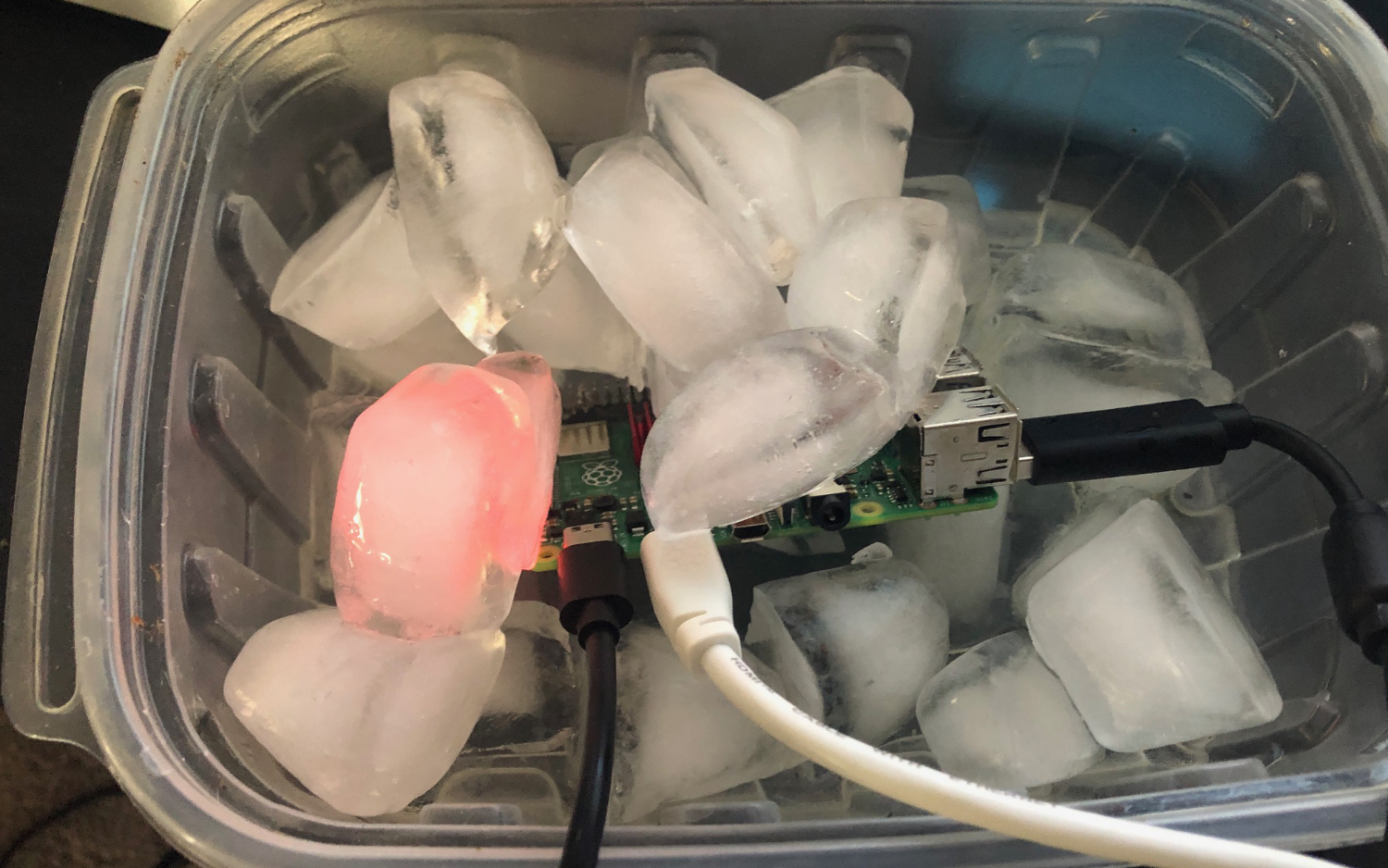Ice-Cooled Raspberry Pi 4 Chills to 8 Degrees Celsius
The Raspberry Pi 4 B is a hot product in more ways than one. That latest and fastest Raspberry Pi achieves new levels of performance that weren't possible with prior models, but it also generates a fair amount of heat, particularly if you're doing intensive tasks, such as gaming.
So, if you're planning to turn your Pi 4 into a retro arcade machine or use it for much more than web surfing, you'll benefit from getting a cooler like the Pimoroni Fan Shim. But sometimes it's fun to push the cooling envelope, and nobody has chilled a Raspberry Pi 4 harder than YouTuber Kio Diekin. The retro gaming videographer submerged his model in a bucket of ice and got it down to a frigid 8 degrees Celsius (46.4 degrees Fahrenheit) while in use at stock settings and 11 degrees Celsius (51.8 degrees Fahrenheit) while gaming at the overclocked maximum clock speed of 2 GHz.
In the video above, Kio Diekin first bathes a Raspberry Pi 4 B in a solution of Corrosion X, a sealant which is designed to protect the PCB from the effects of water. He also says that he treated the metal plugs on the end of the micro HDMI and USB-C cables that provided power and video out for his setup.
With his Raspberry Pi 4 overclocked to 2 GHz and submerged in ice, Kio Diekin then plays a few retro Nintendo 64 games: GoldenEye, Killer Instinct and NFL Blitz. The first game plays smoothly while the second and third titles are a little jerky, but much more playable than they would be without overclocking and without a Raspberry Pi 4 B. Note Kio Diekin is running an unreleased, unofficial build of RetroPie in the video, though he said that he is planning to make this disk image available for download in the near future. Right now, it's a little challenging to do game emulation on the Raspberry Pi 4.
What's really intriguing here is not the gameplay, but the temperatures Kio Diekin was able to achieve with ice. After playing the games for several minutes, the temperature of the overclocked Pi was just 11 degrees Celsius. By comparison, a non-overclocked Pi that we tested with the Pimoroni Fan Shim hovered at around 55 degrees Celsius under load. Even with the giant 52Pi Ice Tower cooler, we saw temps no lower than 46 degrees Celsius under load.
Though the 8 and 11 degree results from ice are very impressive, you don't need that level of cooling to avoid thermal throttling. The Raspberry Pi 4 B starts throttling down its CPU clock when it hits 80 degrees Celsius, so an aftermarket fan that got it to 55 or 65 or even 75 degrees should provide the same performance Kio Diekin got with ice. But it wouldn't offer the bragging rights and the literal cool factor.
If you want to try submerging your own Raspberry Pi in ice, Kio Diekin recommends you check out his series of videos on how to waterproof electronics. A properly treated Raspberry Pi 4 B, he claims, can run for months in outdoor environments or even submerged in water.
Get Tom's Hardware's best news and in-depth reviews, straight to your inbox.
Avram Piltch is Managing Editor: Special Projects. When he's not playing with the latest gadgets at work or putting on VR helmets at trade shows, you'll find him rooting his phone, taking apart his PC, or coding plugins. With his technical knowledge and passion for testing, Avram developed many real-world benchmarks, including our laptop battery test.
-
bit_user I don't think that's what they mean by "Ice Lake".Reply
Are there any waterblocks that work on a Pi4? I'd rather not keep having to fill an ice bucket for my Pi. It's bad enough just keeping ice in my drinks! -
bit_user ReplyWith his Raspberry Pi 4 overclocked to 2 GHz and submerged in ice, Kio Diekin then plays a few retro Nintendo 64 games: GoldenEye, Killer Instinct and NFL Blitz. The first game plays smoothly while the second and third titles are a little jerky, but much more playable than they would be without overclocking and without a Raspberry Pi 4 B.
Let's get this straight. The N64 used a 94 MHz CPU with a 63 MHz GPU. The Pi is easily more than 100x as fast, and it still can't emulate the thing, in realtime? That's pretty sad.
Perhaps a much better optimization would be to use a 64-bit OS! Then, the Pi will at least have the same word-length as the 23-year-old console. -
SirNathan Replybit_user said:Let's get this straight. The N64 used a 94 MHz CPU with a 63 MHz GPU. The Pi is easily more than 100x as fast, and it still can't emulate the thing, in realtime? That's pretty sad.
Perhaps a much better optimization would be to use a 64-bit OS! Then, the Pi will at least have the same word-length as the 23-year-old console.
No computer on earth can perfectly emulate the N64. Hardware limitations aren't the main problem, although it certainly helps in some games to have a 4GHz+ Core i5 or Ryzen 5, the bigger problem is a poor understanding of how the N64 worked. The N64 was far more complex than most of the consoles that came before it (Sega Saturn is an exception), and so emulator developers have had a hard time figuring out some of the details of how it worked, and then re-creating it all. It's much harder to reverse engineer than say, the hardware of the NES or SNES.




